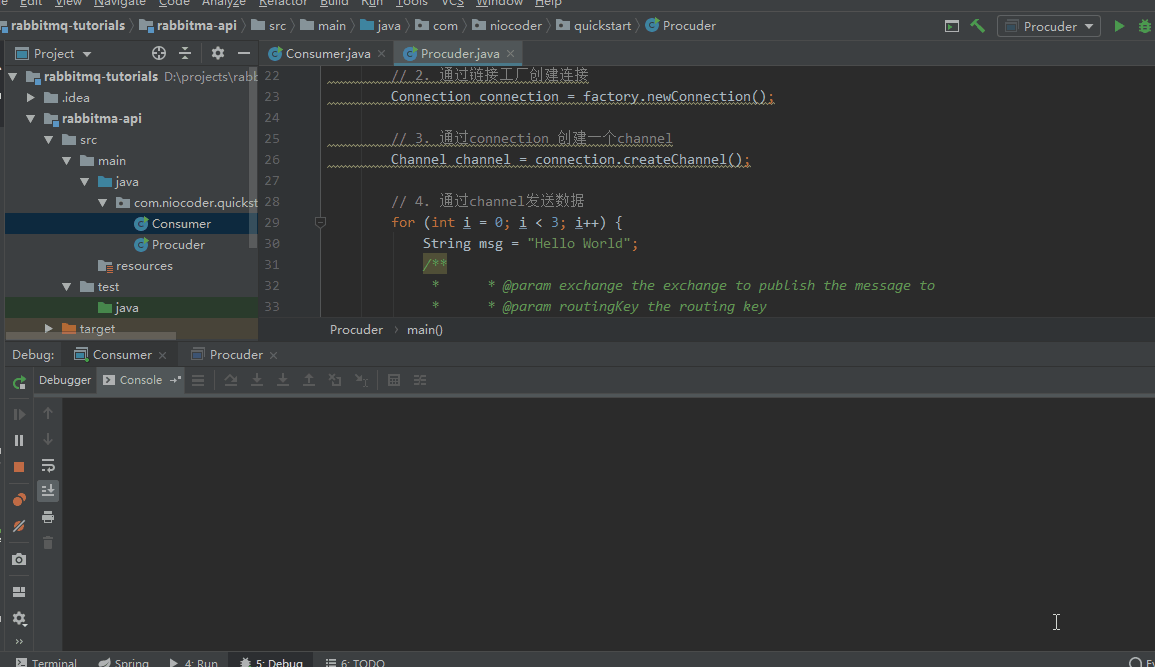生活不止眼前的苟且,还有永远读不懂的诗和到不了的远方。
概述
RabbitMQ是实现了高级消息队列协议(AMQP)的开源消息代理软件(亦称面向消息的中间件)。RabbitMQ服务器是用Erlang语言编写的,而集群和故障转移是构建在开放电信平台框架上的。所有主要的编程语言均有与代理接口通讯的客户端库。
安装RabbitMQ
RabbitMQ下载地址,本系列我们采用docker的方式来安装RabbitMQ,RabbitMQ的docker镜像地址。关于如何docker的安装和使用可参考以下链接;
启动RabbitMQ
docker run -d -p 15672:15672 -p 5672:5672 -e RABBITMQ_DEFAULT_USER=admin -e RABBITMQ_DEFAULT_PASS=admin --name rabbitmq --hostname=rabbitmqhostone daocloud.io/library/rabbitmq:3.7.14-management-alpine
安装完成之后可通过http://localhost:15672/#/访问图形界面(用户名密码均为admin)
RabbitMQ 架构图如下
Server简单来说就是消息队列服务器实体Exchange消息交换机,它指定消息按什么规则,路由到哪个队列Queue消息队列载体,每个消息都会被投入到一个或多个队列Binding: 绑定,它的作用就是把exchange和queue按照路由规则绑定起来Routing Key: 路由关键字,exchange根据这个关键字进行消息投递VHost: 虚拟主机,一个broker里可以开设多个vhost,用作不同用户的权限分离。Producer: 消息生产者,就是投递消息的程序Consumer: 消息消费者,就是接受消息的程序Channel: 消息通道,在客户端的每个连接里,可建立多个channel,每个channel代表一个会话任务
注意:由Exchange、Queue、RoutingKey三个才能决定一个从Exchange到Queue的唯一的线路。
RabbitMQ 消息模型
关于RabbitMQ 消息模型
Direct交换机:完全根据key进行投递。Topic交换机:在key进行模式匹配后进行投递。Fanout交换机:它采取广播模式,消息进来时,将会被投递到与改交换机绑定的所有队列中。
RabbitMQ Hello World
生产者 Procuder
package com.niocoder.quickstart;
import com.rabbitmq.client.Channel;
import com.rabbitmq.client.Connection;
import com.rabbitmq.client.ConnectionFactory;
import java.io.IOException;
import java.util.concurrent.TimeoutException;
public class Procuder {
public static void main(String[] args) throws IOException, TimeoutException {
// 1. 创建ConnectionFactory
ConnectionFactory factory = new ConnectionFactory();
factory.setHost("127.0.0.1");
factory.setPort(5672);
factory.setUsername("admin");
factory.setPassword("admin");
factory.setVirtualHost("/");
// 2. 通过链接工厂创建连接
Connection connection = factory.newConnection();
// 3. 通过connection 创建一个channel
Channel channel = connection.createChannel();
// 4. 通过channel发送数据
for (int i = 0; i < 3; i++) {
String msg = "Hello World";
/**
* * @param exchange the exchange to publish the message to
* * @param routingKey the routing key
* * @param props other properties for the message - routing headers etc
* * @param body the message body
*/
channel.basicPublish("", "hello", null, msg.getBytes());
}
// 5. 关闭连接
channel.close();
connection.close();
}
}
消费者 Consumer
package com.niocoder.quickstart;
import com.rabbitmq.client.Channel;
import com.rabbitmq.client.Connection;
import com.rabbitmq.client.ConnectionFactory;
import com.rabbitmq.client.QueueingConsumer;
public class Consumer {
public static void main(String[] args) throws Exception {
// 1. 创建ConnectionFactory
ConnectionFactory factory = new ConnectionFactory();
factory.setHost("127.0.0.1");
factory.setPort(5672);
factory.setUsername("admin");
factory.setPassword("admin");
factory.setVirtualHost("/");
// 2. 通过链接工厂创建连接
Connection connection = factory.newConnection();
// 3. 通过connection 创建一个channel
Channel channel = connection.createChannel();
// 4. 创建一个队列
String queueName = "hello";
/**
* * @param queue the name of the queue
* * @param durable true if we are declaring a durable queue (the queue will survive a server restart)
* * @param exclusive true if we are declaring an exclusive queue (restricted to this connection)
* * @param autoDelete true if we are declaring an autodelete queue (server will delete it when no longer in use)
* * @param arguments other properties (construction arguments) for the queue
*/
channel.queueDeclare(queueName, true, false, false, null);
// 5. 创建消费者
QueueingConsumer consumer = new QueueingConsumer(channel);
// 6. 设置channel
channel.basicConsume(queueName,true,consumer);
while (true){
// 7. 获取消息
QueueingConsumer.Delivery delivery = consumer.nextDelivery();
String msg = new String(delivery.getBody());
System.err.println("消费端: " + msg);
}
}
}
效果如下:
先启动消费者,再启动生产者


